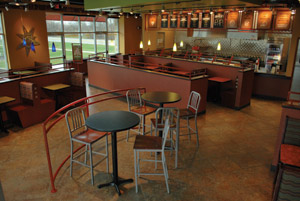How to Update Your Restaurant While Maintaining Customer Service
 Barry Nelson,
Barry Nelson,
Vice President of Operations, Panchero’s Mexican Grill,
Coralville, IowaRestaurant concepts have to find a way to balance innovation in design while maintaining the identity customers already know and love. When making updates foodservice operators should consider a number of factors, including preserving the customer experience throughout renovations as well as how to work with suppliers to get the best possible results. Restaurants should strive to sustain the right atmosphere while keeping the restaurant fresh and looking young.
Restaurant Atmosphere
The core image of a restaurant represents an important part of a brand's identity, and maintaining that identity throughout updates is a challenge. At Panchero's Mexican Grill, our restaurants have a warm, industrial look with open ceilings and a specific color palette that we uphold throughout updates. The general design of the restaurant and dining room is another aspect that we try to preserve throughout renovations. We want to make sure our customers will still understand how the ordering process works and who we are as a restaurant.
We recently made a few changes to give our fast-casual restaurants a more casual dining look. By adding half walls and getting new furniture, we were able to refresh the interior design. We also consistently update table top colors and patterns to make sure we are not becoming outdated.
It's also important to keep the restaurant clean and organized. The furniture in the dining room should be in great condition so even if the interior design doesn't require an update, some furniture may need replacing. We have a showcase kitchen at Panchero's, which allows customers to watch as employees make their food. This means the kitchen has to be as clean and presentable as the dining room at all times.
Artwork and wall coverings are one quick and easy way to freshen a restaurant's image. We recently updated this by changing the media used to display the prints we use. The old style was framed, but our modernized version looks like the prints are stretched canvas, which makes them appear less like reproductions than they did framed. It is the same artwork, but we have given it a cleaner, leaner look to modernize it without spending tons of money.
Other critical parts of a restaurant's atmosphere, like music and staff, are less tangible than furniture and walls. It's important to consider the music playing in the restaurant because it contributes to the vibe of the customer experience. The crew can also help or hinder the atmosphere a restaurant is trying to achieve. We have implemented systems to create an interactive feel by training team members to effectively engage customers and assigning one employee to manage the dining room during peak hours.
Partnership with Suppliers
A restaurant's suppliers can be a great asset when it comes to keeping the design current. It's important to be able to explain a vision and then work with the suppliers to come up with creative solutions to accomplish it. We bounce ideas off of suppliers at the beginning of the process to see if our goals are feasible and cost effective. When suppliers come through, restaurants should have a dining room that looks far more expensive than it actually is.
The key to developing a relationship with suppliers is communication. With open communication suppliers know what to expect from the restaurant and vice versa. We forecast ahead of time so suppliers have a heads up when we may be changing something. We want to make sure we don't leave our suppliers with products they aren't going to use so we use up what they have before making changes. When they need to order more of a product they alert us so we can decide whether we want to make a change. We avoid buying too much of one product that we cannot use in a certain amount of time. We utilize a few trusted suppliers that we know will provide a good product for our corporate-owned stores and franchised locations.
 One goal is to provide affordable products to franchisees. Longevity is important because the longer products last, the better the value. We know our suppliers need to make money so we buy products in bulk by purchasing for more than one store to get a better deal on price. We also like products that can be replaced in parts. For example, the seats, the seat backs and the fabric on our booths can be replaced individually to save money. In our college markets, we get a lot of damage in addition to the normal wear and tear — like fading in the fabric — so this is important.
One goal is to provide affordable products to franchisees. Longevity is important because the longer products last, the better the value. We know our suppliers need to make money so we buy products in bulk by purchasing for more than one store to get a better deal on price. We also like products that can be replaced in parts. For example, the seats, the seat backs and the fabric on our booths can be replaced individually to save money. In our college markets, we get a lot of damage in addition to the normal wear and tear — like fading in the fabric — so this is important.
Many years ago, we had all wood booths that did not really fit our concept. They looked more like park benches and were not special to the Panchero's brand. We added fabric to individualize the booths, but we still had a problem with the wood part of the booths. The mop water was causing the wood to break down. Working with our suppliers, we came up with a laminate wood combination that is more durable for water and scratching. The outcome gave us proprietary booths that are special to us instead of a standard stock item and our new design is longer lasting.
The hardest part about keeping restaurants current is managing and keeping track of which restaurants have which design. We maintain records at the corporate office and our vendors also track what we have and where. We want to make sure that when there is something new and better, it gets into the franchised stores.
The Renovation Process
We always test big changes in a corporate restaurant first to see how the products hold up. We do this with everything from booths and signage to paint colors and lights. Typically, we try them out in a corporate store for nine to 12 months. After we evaluate the failure rate and installation process, we make a decision on whether the change should be made. We want to make sure we have the right fit before we send a product to the franchise owners to purchase.
We review our restaurants every five years to freshen the image and update them, but some restaurants need to be renovated sooner. Franchise consultants also observe the restaurant to see what is failing and needs work. After they report back to the corporate office, we make a prioritized list of what needs to be done with price estimates. It is up to the franchise owner and their consultant to carry out the changes.
The process of renovating an existing restaurant can be a challenge. The main goal should be to uphold a high customer service level even while making the updates. We try not to close the restaurant because we do not want to lose the business so we do most of the work after hours. If there comes a point when we have to close the restaurant for things like floor work or to build a new half wall inside the dining room, we keep the time a restaurant is closed to a minimum, and typically it only has to be closed for two to five days at most. We also try to complete renovations at the right time of year. Restaurants are typically slower in January and February so that is a key time. For our locations near college campuses, we will do the updates when the students are on break.
It is critical to make sure customers never see work being done. It is up to the crew to know how long a project will take. They should not start a project if it cannot be completed by the time the employees come in the next morning.
Keeping a restaurant looking young is critical to its success. By developing a great relationship with suppliers, restaurateurs can find the right products to take their business into the future.



